35+ Practical community engagement ideas to reignite buzz
You’ve built a community you’re proud of. But after the excitement of launch, you might notice things go silent. That’s completely normal. Every community goes through natural engagement dips.
What sets seasoned community builders apart is that they don’t panic. Instead, they reach for a playbook of proven ways to spark connection and get members participating again.
If you don’t yet have that playbook or you’re looking to expand it, you’re in the right place. In this guide, we share 35+ practical community engagement ideas, along with real examples, to help you re-energize your space. Think of it as a toolkit you can return to anytime your community feels a little quiet. Bookmark it now! 🔖
Go ahead, we’ll wait!
Principles of meaningful engagement
Before diving into ideas, let’s take a moment to ask: what does meaningful engagement really look like? Many new community builders jump straight into giveaways or random prompts, but those can come across as forced. True engagement isn’t about quick hacks—it’s about creating a steady rhythm you can sustain.
Here are three simple principles that matter most 👇
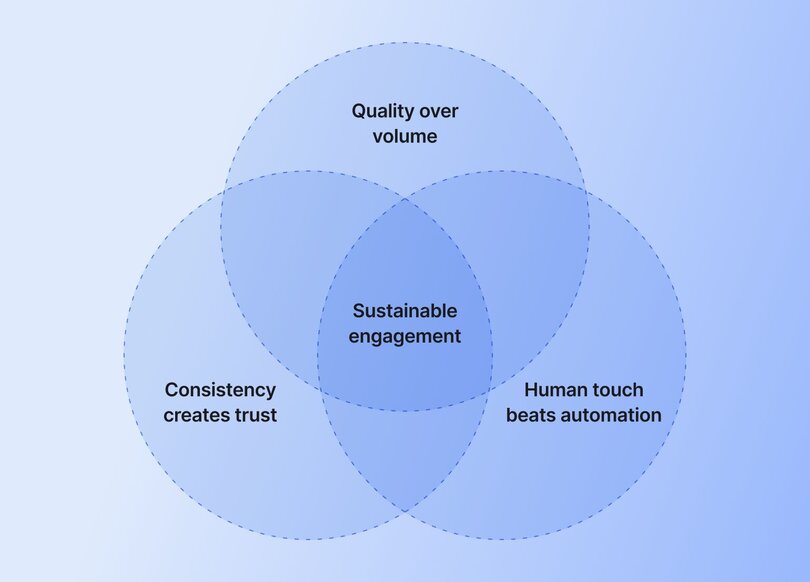
- Quality over volume. More posts don’t always mean more participation. Focus on fewer, intentional prompts that spark stories, progress updates, or peer support. Define what “meaningful” looks like for your community, then measure against it. For example, if your space supports mothers building businesses, asking about their favorite car model won’t resonate. For a deeper framework, explore our online community engagement playbook.
“Engagement is a measurement of whether your members are taking actions that help them along their growth journey. These actions should help them with their actual goals, not just make the community feel busy.”
– Tatiana Figueiredo, community business strategist
- Consistency creates trust. Members engage when they know what to expect. Establish weekly rituals, a steady event cadence, clear spaces for specific types of engagement, and a simple content calendar. Think “Monday goals,” “Wednesday wins,” or a monthly theme. Consistency lowers friction and helps participation become a habit. If you need practical planning tips, check out our guide to community engagement strategies.
- Human touch beats automation—but the two can work together. Tools are incredibly useful for handling repetitive tasks, like sending welcome DMs, reminders, or event follow-ups. But you should also carve out time for personal interactions, such as a quick DM or a shoutout in the community feed, since these moments feel extra special for the person on the receiving end.
In short, think of community engagement as touchpoints that make it easy for members to connect in ways that feel meaningful.
35+ Community engagement ideas
Now that we’ve covered the principles, let’s get into the practical side. To start, here are some quick tactics you can try right away.
Quick wins (low-effort, high-impact)
Quick wins are small, easy-to-launch conversation starters that give members a reason to participate without much effort. They’re especially useful during slower weeks or when you want to lower the barrier to engagement.
- Daily or weekly polls: Polls are one of the fastest ways to invite participation. They’re low-lift for members (just one click) but can spark follow-up discussion in the comments. Keep them simple and relevant to your community’s goals.
- “Introduce yourself” thread refreshes: Revisit your welcome thread every few months and invite new members to introduce themselves. Tag existing members to welcome them, as that makes your community feel alive and supportive. If your community runs in cohorts, this thread gets better with every new cohort. At our own Circle community, we have a “Say Hello” page where we encourage members to introduce themselves, share their stories, and ask for support if they need it.
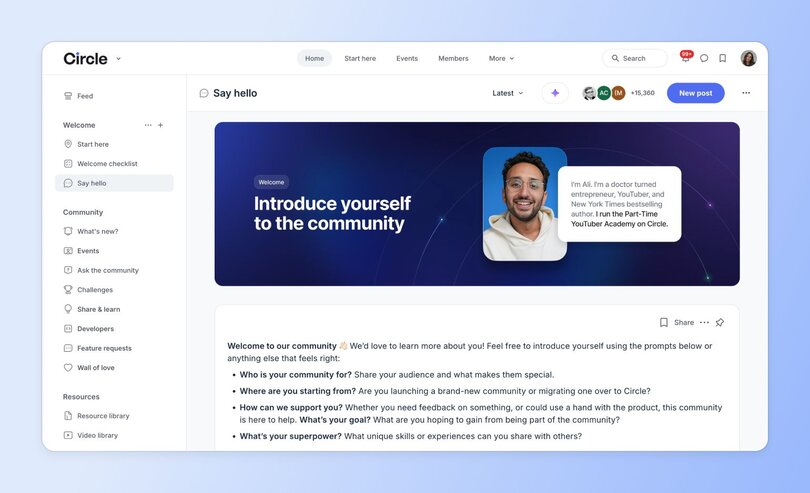
- Gratitude shoutouts: Start a post highlighting members who’ve contributed something valuable. A simple thank-you builds recognition, encourages repeat participation, and shows members you notice their effort.
- Two-sentence prompts: Ask members to share something short and specific, like their biggest win of the week or one challenge they’re working through. The smaller the ask, the easier it is for people to jump in.
Content-driven activities
Content-driven activities give members something fresh to respond to and talk about. They’re simple to set up, but they create a steady flow of conversations and make members feel part of something ongoing.
- AMAs (Ask Me Anything) with experts or members: Spotlight a guest expert or a well-known member and open the floor for questions. You can run it as a thread or host it as a live event.
- Member spotlights/profiles: Highlight one member at a time with a short interview or Q&A. That’s not only a great way to make your people feel seen and valued, but also gives the rest of the community someone new to connect with. Encourage others to comment, celebrate, or ask follow-up questions.
- Themed weekly posts (Motivation Monday, Wins Wednesday): Create recurring posts that members can count on. Themes give people an easy entry point to participate and start conversations. Keep them short and consistent so they become part of the community’s rhythm.
Moms at Work, a networking and career Circle community for working moms, celebrates everyone’s Friday wins—and it's one of their most engaging rituals. Turns out, if you have the right people in your community, members love celebrating each other. 🙂
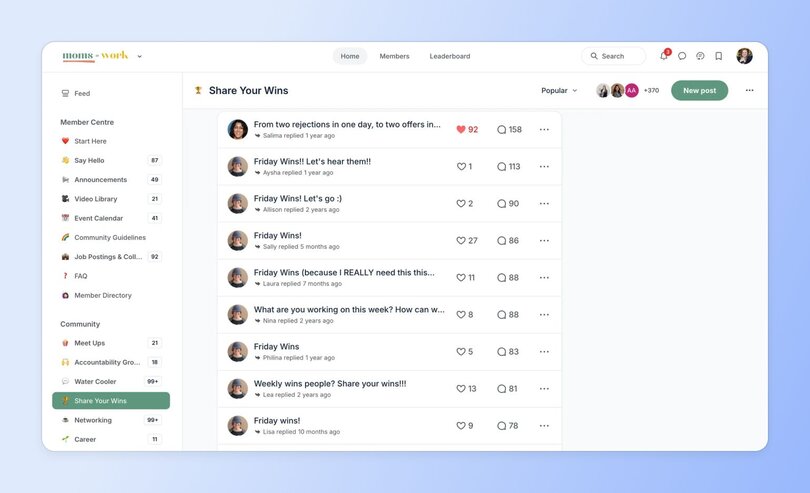
- Challenges (30-day content, habits, etc.): Who doesn’t love a good challenge? 🙋♀️ Consider running a short challenge that ties to your community’s goals, like a 30-day content sprint or a daily habit check-in. Challenges build accountability, spark conversations, and give members a sense of progress to celebrate together.
Musical Nest, a Circle community that brings parents and teachers together to help kids build joyful music practice habits, runs a 30-day practice challenge where even small actions like logging a practice session or giving a 👍 in the thread count toward progress.
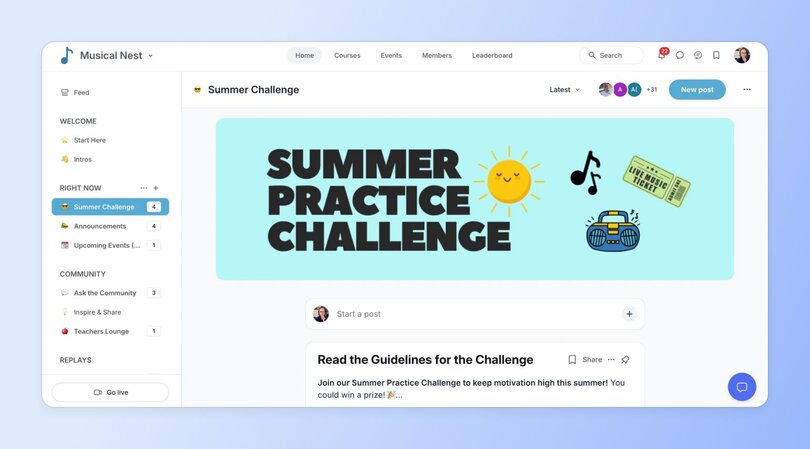
As part of it, they give out small prizes, like stickers and tote bags, to keep things fun and motivating. Members love it, and, as you can imagine, engagement rates shoot up.
Events & shared experiences
In 2025, live community events are more than a nice-to-have—they’re essential. Our Community Trends Report shows that 78% of communities run educational workshops or trainings, 60% host small group discussions or peer support sessions, and nearly half offer open office hours or Q&As.
Virtual events have become a secret weapon for building deep connections and boosting member retention.
- Virtual co-working sessions: Host a focused workroom where members drop in, share what they’re working on, and hold space together.
Freelance writer and community founder, Jasmine Williams, runs weekly virtual coworking sessions in The Reach Club, a coworking community for work-from-home creatives.
These weekly sessions “have easily become the highlight of my week,” says Jasmine. “There’s no performance or pressure to be ‘on.’ It's just a focused, chill space to actually finish the things you keep moving down your to-do list with other creative folks doing the same.”
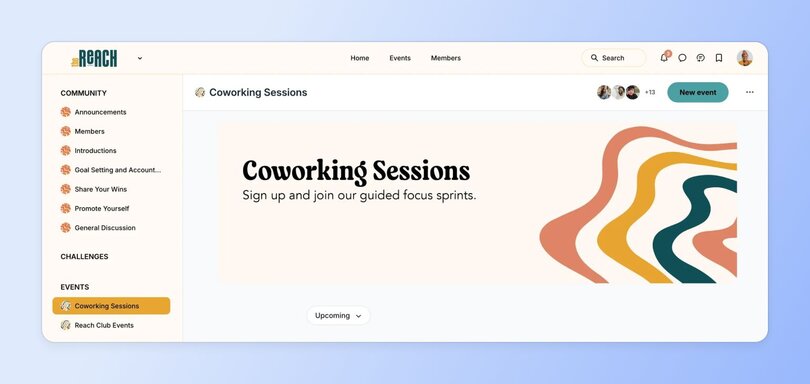
- Watch parties or book clubs: Pick a video, podcast, or book relevant to your group and experience it together. Follow up with a discussion thread or casual chat so members can process ideas in real time (#BookTok friends, gather here)—and connect around them.
For example, the folks over at The Novelry—a community for writers where writing is serious fun—have a fabulous way of setting up their book club alongside other workshops and events.
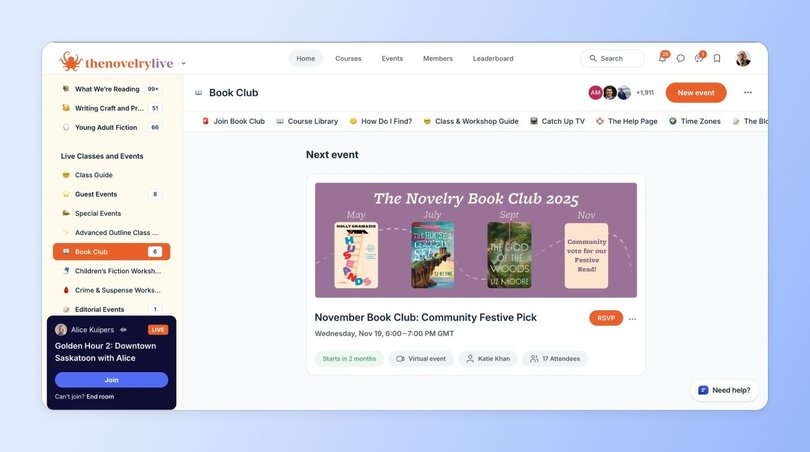
- Member-led sessions (workshops, case studies): Let members share their skills through workshops, demos, or case studies. This can do two things: highlight the talent within your community and create learning opportunities directly from peers.
- Surprise pop-up events: Plan occasional unannounced sessions, such as informal check-ins or coffee chats. These low-stakes events can add variety and spark fresh interactions when things feel slow.
Gamification & rewards
Another idea for community engagement is adding a layer of gamification. Points, badges, and rewards tap into people’s natural motivation to play, compete, and be recognized—all while keeping participation fun.
- Points/badges for participation: Reward members with visible points or badges when they contribute. Recognition doesn’t have to be big—small signals of progress can make people feel valued and encourage repeat engagement.
- Streak-based rewards: Encourage consistency by celebrating streaks, like posting three days in a row or showing up to three events in a month. You can do this automatically with workflows in Circle.
- Monthly leaderboards: Highlight top contributors in a leaderboard to inspire friendly competition. To keep it fair and inclusive, recognize different types of participation, not just who posts the most.
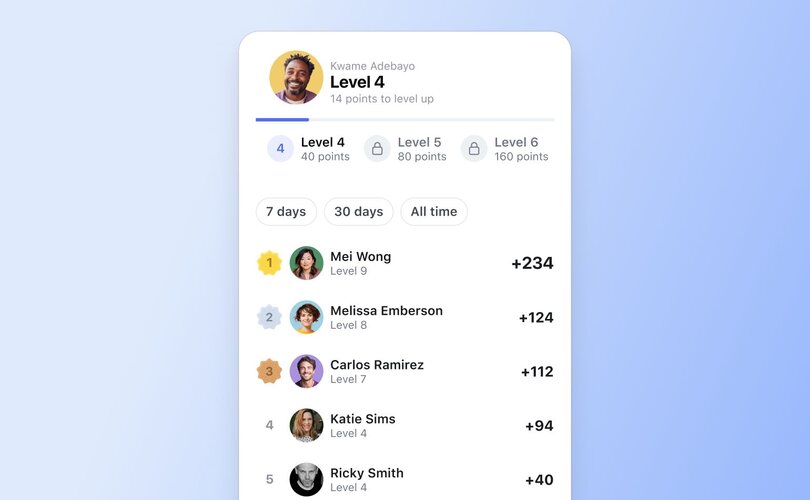
- Raffles/contests tied to engagement: Run a raffle where actions, like posting, commenting, or attending an event, earn an entry. It’s a fun way to reward activity while keeping the outcome exciting and unpredictable.
Gamification in action:
Community strategist Ashley Gore launched an achievement program using Circle’s gamification features in Pat Flynn's Smart Passive Income (SPI) community. Members earn points for simple actions like liking posts or completing the onboarding checklist, then unlock non-monetary rewards such as shoutouts, hot seat spots, and exclusive badges. By focusing on recognition over ranking, the program encourages generosity and collaboration instead of shallow competition.
The payoff? A livelier feed where members feel motivated to contribute in meaningful ways.
🎮 The gamification unlock for big impact: Small teams (ie. most community teams) can't manually reward thousands of members, but Circle's gamification + workflows can. Set automated systems that reward knowledge sharing, event attendance, or whatever behaviors you actually want to see scale. No community manager burnout, no endless list of to-dos.
The workflow piece is the real differentiator—most platforms give you basic points, but Circle lets you build sophisticated if-then automations that trigger rewards based on specific behaviors and integrate with your existing systems.
What gets rewarded automatically:
- Content creation - publishing events, starting discussions, sharing resources
- Engagement activities - commenting, liking posts, RSVPing to events, attending live sessions
- Learning milestones - completing courses, passing quizzes, finishing lessons
- Special recognitions - upgrading memberships, earning specific tags from admins
The key is designing reward systems that align with your community goals and run completely hands-off once set up.
Personal touch (humanized engagement)
As a community manager, it’s worth taking time to engage with your members one-on-one. It doesn’t have to be big gestures. Often, it’s the small, personal touches that make people feel seen and connected. Here are some ideas:
- Personalized DMs for inactive members: Reach out with a short, friendly message to members who haven’t been active lately. A quick DM lets them know they’re missed and always welcome back. You can also send messages to introduce members who have something in common. Tom Ross, for example, sends DMs every week in his Learn.Community to introduce like-minded members and encourage connections. Simple and effective!
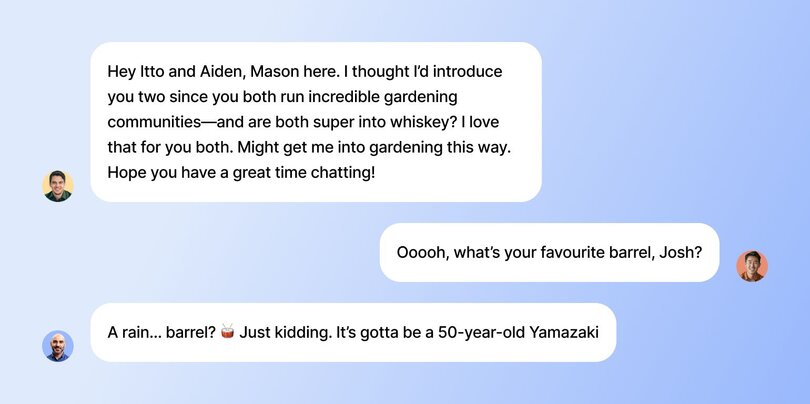
- Birthday or milestone shoutouts: Celebrate personal moments like birthdays, anniversaries, or a member’s first year in the community. Public recognition helps members feel connected and cared for.
- Handwritten thank-you notes for top contributors: Digital thanks are easy. A handwritten card? That’s rare. Which is why it can hit differently and stick with your members.
- Member welcome buddy system: Pair new members with a “buddy” who’s been around longer as a way for newcomers to get settled and build relationships faster.
📣 Humanizing engagement, especially in the early days of your community, is super important because it’s those personal moments that keep members coming back every day. Jordan Godbey, community growth genius, said it best:
“When a member posts, they should receive a valuable and timely response from you or others. This creates a positive feedback loop and makes them think, “Hey, whenever I have a problem, question, or win, I’m going to throw it in the community because I know I’ll get a response and it’ll benefit me and others.”
This subconscious feeling and expectation can only be developed through practice, so make sure you encourage and respond to all early posts with as much value as you can bring to solidify that positive feedback loop!”
—Jordan Godbey, community strategist and founder of Growth Community
Collaboration & co-creation
Communities are at their strongest when members aren’t just consuming content but creating together. Collaboration gives people ownership, deepens relationships, and helps to work through different challenges together.
- Peer coaching pairs: Match members in pairs so they can coach each other through challenges. The one-on-one connection creates accountability and helps members build lasting relationships.
- Group resource swaps (templates, tools, tips): Set up a space where members can exchange resources like templates, tools, or guides.
- Member-led learning groups or masterminds: Encourage members to form small groups around shared goals or challenges. Because these sessions are peer-led, you don’t have to be involved 24/7 in running them.
- Community-driven project showcases: Invite members to share projects they’ve built, designed, or launched. Showcases celebrate talent, inspire others, and highlight the real impact your community is having.
Seasonal & creative sparks
Most communities overlook seasonal trends, but it’s one of the easiest ways to engage your community members. Leverage holidays, seasons, and cultural moments to give your members something timely to rally around.
- Holiday-themed prompts (Valentine’s, Halloween, etc.): Holidays are perfect for tapping into nostalgia. Start a thread asking about the best (or worst) Valentine’s gift, favorite Halloween candy, or a New Year’s tradition they’ll never skip.
- Seasonal challenges (summer sprint, winter reflection series): Run short challenges that tie into the season. For example, in the fall, you could do a “30 posts in 30 days” challenge on personal social media. In December, run a “3 lessons from this year” reflection thread where members share what they’ve learned before heading into the new year.
- “Year in review” celebrations: If you need a super-effective idea to close the year with your community, do a “Year in review” celebration where you collectively reflect on the past year. Highlight top contributions, biggest wins, and key milestones.
For example, Mike Williams (Yoroonie), founder of the Everything Marketplaces community has been posting a year in review in the Circle community since 2021—and it just gets better and better every year.
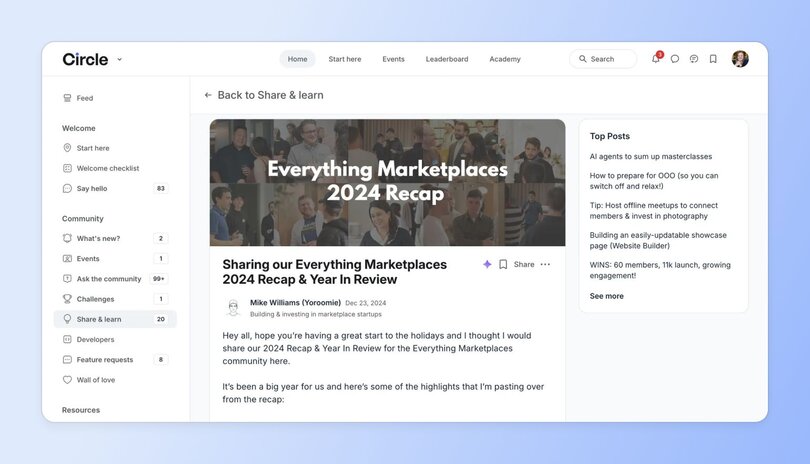
- Seasonal community playlists, recipes, or traditions: Invite members to co-create something seasonal, like a playlist, recipe swap, or holiday tradition unique to your space.
Recently, to celebrate the launch of Circle’s Website Builder, we ran a challenge inviting members to create their own community sites with the tool. It quickly became our most popular challenge yet (over 100+ submissions within 2 weeks!) and created huge buzz. Members didn’t just share their sites—they jumped into the comments to swap tips, ask questions, and cheer each other on.
Conclusion? Challenges = guaranteed, community-powered, focused engagement.
Advanced engagement systems
Now, without you asking, we’re going to throw you straight into the deep end. Just kidding. But once you’ve tried the quick tactics, it’s worth stepping up to more advanced strategies.
These systems help you future-proof your community by setting up scalable, repeatable processes that keep engagement running without relying only on your time.
- Automated engagement funnels (welcome → onboard → activate): Create workflows to onboard new members. For example, start with an automated welcome DM, follow up with a nudge to introduce themselves, and then invite them to their first event. Circle makes this super easy with automated workflows that handle repetitive onboarding tasks at scale, like sending personalized welcome messages, connecting members to peers, and adding them to the right spaces from day one.
- AI-powered personalization for content or event suggestions: Use AI tools (like AI agents or workflows—both unlocked at enterprise level) to recommend relevant content, groups, or events to each member. For example, someone who engages with marketing threads could get a prompt to join an upcoming “Content Strategy” workshop.
- Tiered engagement paths (free → advanced → VIP): Give members a clear path to deepen their involvement. Start with free discussions, then invite them to advanced groups, and eventually unlock VIP perks like private masterminds or exclusive events. With tiered paths, you can motivate members to keep leveling up their participation.
- Member-to-member marketplace or exchange: Open up spaces where members can share services, templates, or offers with one another. This not only creates value between members but also positions your community as a hub where opportunities happen. For example, ExitFive runs a fantastic job board that’s undoubtedly powered by the community referral engine.
- Engagement-to-revenue attribution systems: Track how engagement drives conversions, whether it’s course enrollments, event signups, or premium upgrades. Understanding which touchpoints lead to revenue (via analytics) helps you double down on the strategies that both serve your members and sustain your business.
Best practices for community engagement
You’ve got the tactics, but lasting engagement requires you to look at the bigger picture, trends over time, and really have your finger on the heart of your community. Here are a few best practices to help your community thrive long term.
Match tactics to community size & stage
The right engagement strategy depends on where your community is in its journey. Early on, when you have 50 members or fewer, lean on high-touch tactics like weekly check-ins, personal DMs, and direct conversations. These help early members feel noticed and build a strong foundation of trust.
But as your community grows, your approach needs to evolve, too. At 500 members, personal DMs to everyone aren’t realistic. Instead, focus on scalable systems—things like structured events, recurring content themes, or member-led groups. The goal is to give people reliable touchpoints without putting all the weight on you.
Avoid engagement fatigue
Throwing all 30+ engagement ideas into your community won’t automatically solve slow member activity. In fact, you’re better off picking a few tactics and rotating them or experimenting with different formats on a recurring basis. Engagement should never feel forced—that’s the fastest way to make your efforts fall flat.
Build systems to scale
Something you’ll also want to reduce is your own involvement in every single initiative—even though it’ll be hard to step back. A better approach is to use workflows, member-led initiatives, or recurring rituals or habits that keep running even when you’re not present.
🧠 Scalable systems create space for sustainable growth. Find out how Bonnie Christine realized it was time to scale up, and delegate confidently.
How to build an action plan
Engagement ideas—check ✅.
Best practices—check ✅.
Now it’s time to bring it all together. The final step is turning inspiration into a simple action plan you can actually follow. Here’s where to start:
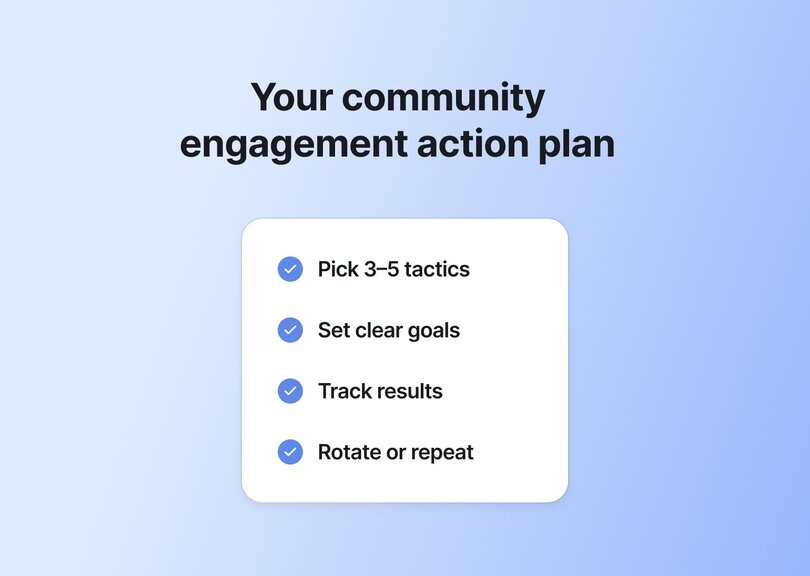
- Pick 3–5 tactics per month (or simply an amount that feels achievable). Balance your mix with quick wins (polls, gratitude shoutouts), deeper activities (member spotlights, AMAs), events (co-working sessions, live Q&As), and one new experiment you haven’t tried before (a seasonal challenge or a surprise pop-up coffee chat).
- Set clear goals. Decide what you want each tactic to achieve, such as more comments, higher event turnout, or stronger peer-to-peer interaction.
- Track results. Use simple metrics such as reply counts, attendance, or member feedback to see if your engagement efforts are working. If they aren’t, pivot to other tactics instead of continuing with what doesn’t work.
- Rotate or repeat. Retire tactics that don’t deliver much, double down on what works, and reintroduce proven ideas later so they feel fresh again.
Ready to re-engage your community?
So there you have it: 35+ engagement ideas, best practices, and a simple plan to put it all in motion. Like we said, don’t try to do it all. Focus on what makes sense for your community right now. The best approach is to run short sprints, see which ideas spark the most participation, and build from there.
And if you need a tool to help, check out Circle—the all-in-one community platform. With spaces for discussions, live events, courses, gamification, payments, and automations, Circle brings all the community management tools under one roof.
FAQs about migrating Facebook Groups
What are examples of community engagement activities?
Community engagement activities can range from quick wins to structured experiences. Examples include:
- Polls and prompts that spark quick conversations
- AMAs with guest experts or well-known members
- Member spotlights to highlight contributions and stories
- Gratitude shoutouts to recognize helpful members
- Virtual co-working sessions for real-time productivity and connection
- Book clubs or watch parties to create shared experiences
- Workshops or trainings that provide value while building community
How do you increase participation in an online community?
The most reliable way to increase participation is to lower friction and make it easy for members to engage.
Start with simple prompts or polls that only take a few seconds to answer, then build toward deeper conversations or events. You should also not forget personal recognition, like shoutouts or milestone celebrations, since these make members feel valued and more likely to return.
Over time, rotate activities to prevent fatigue and keep participation fresh.
How do you measure success in community engagement?
Success in community engagement depends on how well participation aligns with your goals. Let’s say you introduce 3–5 new tactics. Give members a little time to engage, then track specific metrics for each activity.
For example, if you run an AMA, you might measure success by the number of questions asked, comments in the thread, or follow-up conversations that happen afterward.
- For events, look at registrations and attendance.
- For challenges, track completion rates.
Over time, the clearest sign of success is that members feel invested enough to participate consistently and contribute on their own.
How do you maintain engagement as your community grows?
As your community grows, move from high-touch, one-to-one tactics to systems that scale.
Automate onboarding, set up recurring rituals, and invite members to take on leadership roles. You can also mix in structured events, tiered spaces, or gamification to keep things engaging without stretching yourself thin.